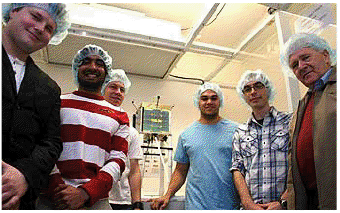Massey students create space satellite software
A team of Massey University engineering students is building software for New Zealand’s first spacecraft.
The satellite, named KiwiSAT, could pave the way for a new generation of satellites to measure polar ice thickness, biomass and other environmental data needed in monitoring climate change.
Four fourth-year honours students and a Masters student from the School of Engineering and Advanced Technology at the Albany campus have been awarded a $7,500 grant from the New Zealand Association of Radio Transmitters’ Radio Science Education Trust to develop the software. The micro satellite is the size of a basketball and will be launched from a Russian rocket in the northern hemisphere when the project is finished.
KiwiSAT is being designed and built by a team of volunteers from New Zealand Radio Amateurs supported by Massey and various corporate sponsors. It will connect with amateur radio stations globally and will carry out experimental work in small satellite Attitude Determination and Control (ADAC) – a low cost control system that works through interaction with the Earth’s magnetic field to position the satellite at a specific attitude.
Trustee Peter Norden, who presented the cheque to the students this week, says the grant – the biggest the trust has given in its 13 years – will “help take the KiwiSAT project to a most important stage of development”.
The funding will enable the students to continue with practical system design, testing and software development, and the development of the ADAC package to measure the satellite’s attitude in relation to the earth’s surface and control it relative to the direction of the earth’s magnetic field.
KiwiSAT project manager Fred Kennedy says the research is vital to ensuring the satellite can fulfil its dual experimental purpose in space; to test technology for the accurate positioning of a small satellite that could open up possibilities for similar low-cost, low-risk satellites in environmental monitoring, and to expand communications for amateur radio operators for diverse uses.
Mechatronics lecturer Associate Professor Johan Potgieter, who is supervising the team, says the project is a valuable one for Massey engineering students. “It shows we have the capability in this country to be involved in new areas we traditionally haven’t been seen to have a force in, like satellites and space. We teach our students that engineering involves innovative ways of solving problems, and transferring knowledge to exciting projects like this.”
